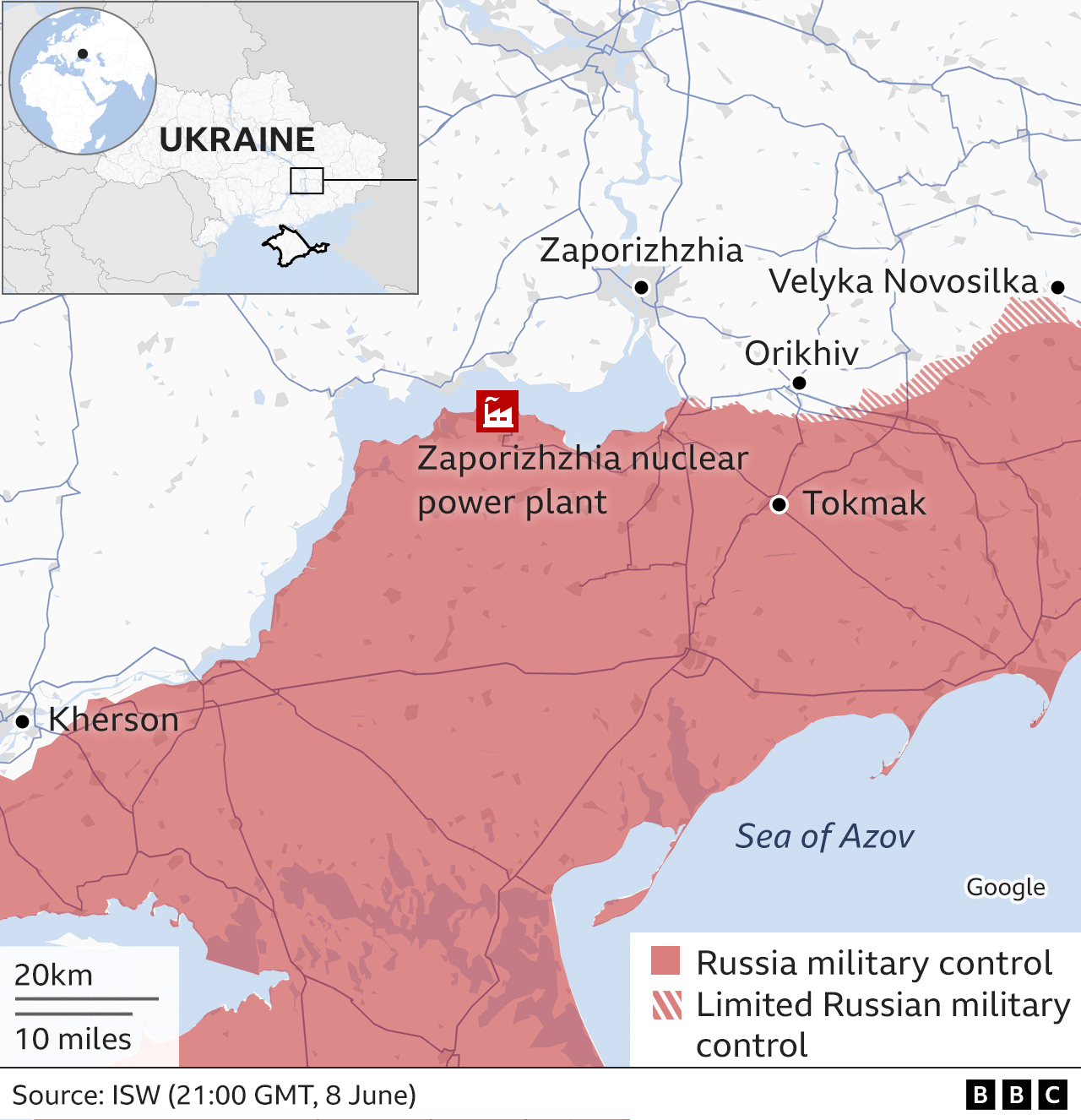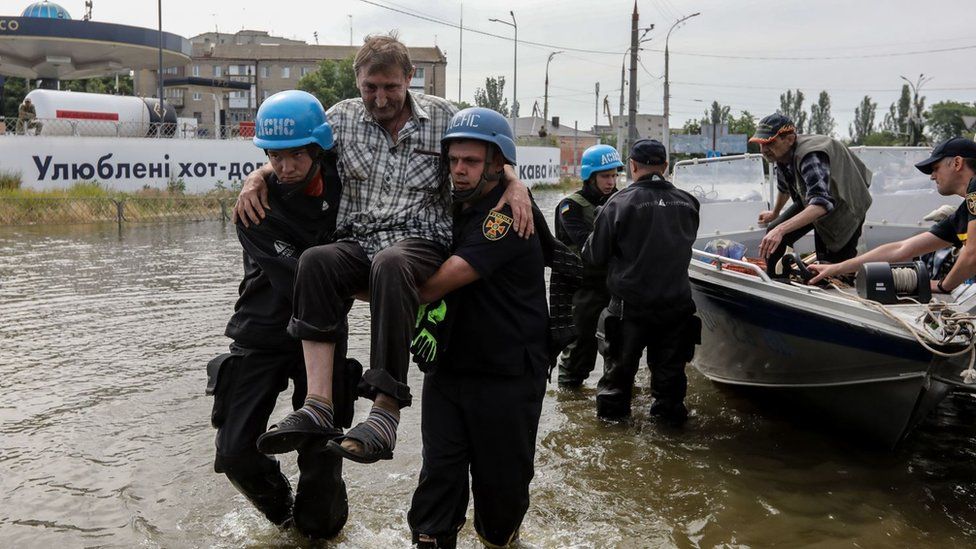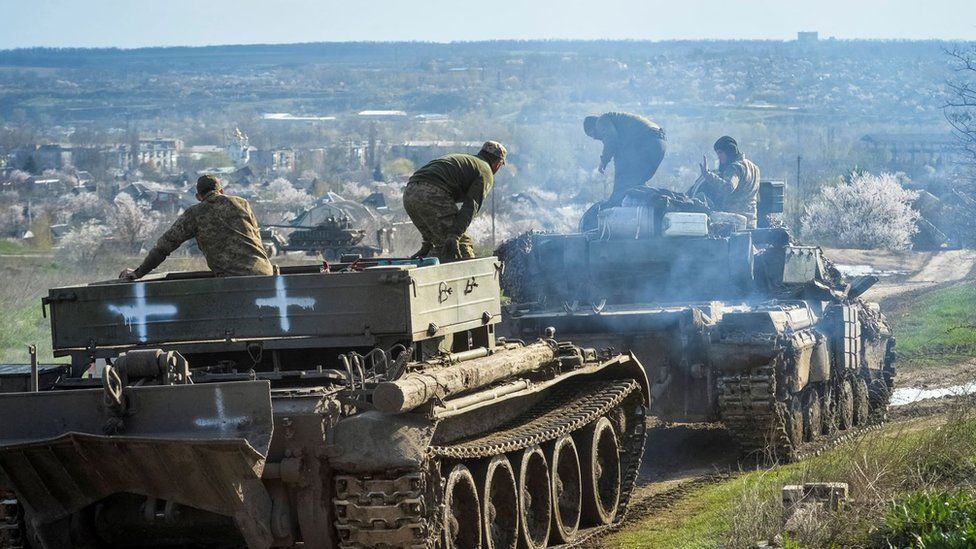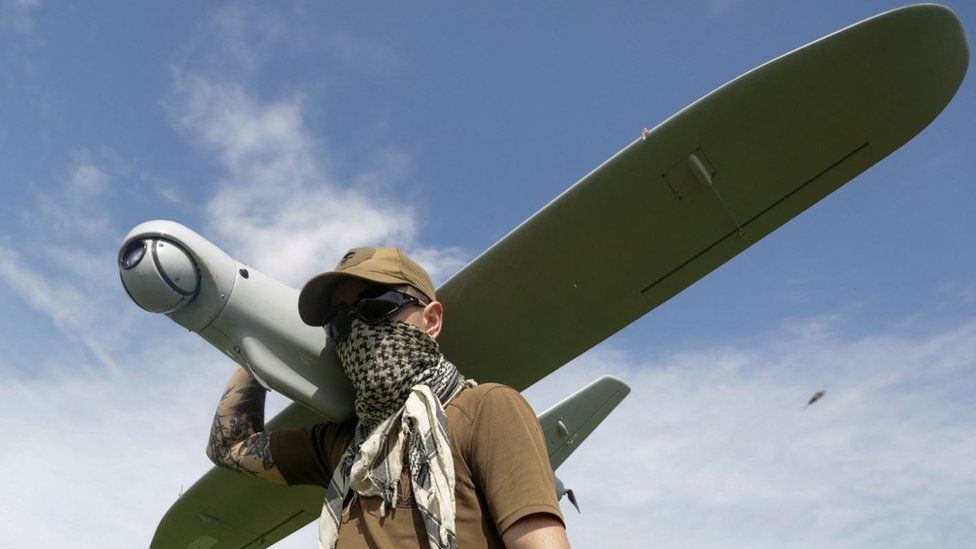Was this the week that Ukraine's long-anticipated counter-offensive finally got underway?
Russian President Vladimir Putin seems to think so. "We can definitely state that this Ukrainian offensive has begun," he said in a video interview published on Telegram on Friday.
In some ways, it's already been under way for weeks, with Ukraine conducting what's known in military jargon as "shaping operations": long range artillery and missile attacks on key Russian logistical targets far behind the front lines.
Monday seemed to herald a change, with small detachments of lightly armoured Ukrainian units moving forward across the open fields towards Russian fortifications in southern Ukraine, south-east of Zaporizhzhia.
"Now the so-called 'fighting reconnaissance stage' is taking place along the entire length of the front," Serhii Kuzan, co-founder and chairman of the Ukrainian Security and Cooperation Centre, told the BBC.
"That means there's a probing of Russian defences."
Some videos and accounts suggested that they quickly ran into trouble.
"Somewhere this happens more successfully with small losses," Mr Kuzan said. "And somewhere less successfully, where the Russians fight back."
Mr Kuzan declined to name specific towns, saying only that they were all in the area south of Zaporizhzhia.

By Tuesday, the world's attention was captured by the destruction of the dam at Nova Kakhovka and the subsequent flooding that soon covered around 230 square miles (596 sq km) either side of the Dnipro River.
For all the Kremlin's denials, it didn't look like a coincidence. The dam, and the road across it, offered a possible line of attack for Ukrainian forces looking for ways to keep Russian forces off-balance.
It seems highly likely that Russian forces, which controlled the dam, decided to blow it up, taking one of Kyiv's military operations off the table.
Kyiv had already signalled its interest in this stretch of the front line more than once.
In late April, Ukrainian soldiers crossed the river and briefly established a bridgehead at Oleshky. Ukraine also took control of several small islands in the Dnipro delta, close to Kherson.
The extent of Kyiv's military plans for this area is not known, and is now academic. The catastrophic flooding will have made river crossings impossible for the time being.
"But the fact that such a direction was an option was seen by the Russians," Mr Kuzan said.

While the authorities in Kyiv suddenly grappled with the flooding, the fighting continued - and seemed to escalate - further east.
By early Thursday morning, the UK's Ministry of Defence tweeted that "heavy fighting continues along multiple sectors of the front," adding that in most areas "Ukraine holds the initiative."
In a video the same day, Russia's defence minister, Sergei Shoigu, said that Russian forces had repelled an overnight Ukrainian attack in the area south of Zaporizhzhia, involving 150 armoured vehicles and 1,500 troops.
According to the Russian Defence Ministry, Ukraine's 47th Mechanised Brigade "made an attempt to break through Russian lines."
A video circulated on the internet, purporting to show something new: a western-supplied Leopard tank being destroyed. The BBC has not yet verified the video.
Ukrainian officials, characteristically tight lipped about current operations, offered tantalising glimpses into what was going on.
Hanna Malyar, the Deputy Defence Minister, coyly said that Russian troops were "actively on the defensive" in the area around the town of Orikhiv, around 65km south-east of Zaporizhzhia.
In a statement on Telegram, she also confirmed that battles were continuing around Velyka Novosilka, further east.
The two towns likely form the western and eastern edges of a heavily fortified stretch of the front line where many analysts believe Ukraine will eventually try and punch through Russian lines.
"It's not a secret that one of our main goals is to cut the land corridor that feeds the whole southern grouping of enemy forces," Mr Kuzan said.

Pro-Russian Telegram channels in the Donbas were full of excited chatter about Ukraine's latest moves, much of it laced with scorn.
"They are going where the Russians are waiting for them," one member posted in the I Love Kramatorsk group. "What stupidity!"
Others acknowledged that Ukrainian forces had moved forward, but questioned the price in lost men and armour.
"I really question the price of this success," another member of the same group commented.
"Do they have enough forces to reach Tokmak [44km south of Orikhiv], let alone Berdyansk and Melitopol?"
But it's not the only area where fighting is raging.
Footage from north and south of the city of Bakhmut, scene of one of the longest and bloodiest battles of the war, appeared to show Ukrainian forces moving forward.
Ms Malyar said they had advanced "from 200 to 1,100 metres in various sections," in what may eventually be an effort to encircle the city and trap its Russian occupiers.
It is, as the UK's Ministry of Defence noted, "a highly complex operational picture".
But does it mean that Ukraine's counter-offensive is already entering a dramatic new phase?
On Wednesday, Oleksiy Danilov, Secretary of Ukraine's National Security and Defence Council, scoffed at the idea.
"All of this is not true," he told Reuters.
"When we start the counter-offensive, everyone will know about it. They will see it."

But something has definitely changed.
"The point is that the front is finally moving," Serhii Kuzan said, adding that several options were still open to Ukrainian commanders.
But Ukraine is also operating under a number of significant restraints, the main one being the lack of fighter jets capable of providing support from the air.
"That's why we move slowly," Mr Kuzan said, "and then move air defence [systems] closer."
Another factor is time. This offensive will probably last no more than five months, after which autumn rain will once again render open ground impassable for heavy armoured vehicles.
What will success look like?
If Ukrainian forces can punch through Russian lines, all the way to the Sea of Azov, then any Russian troops west of that breach will suddenly be much more vulnerable, dependent entirely on supply lines through the Crimean Peninsula.
All that would then remain, Mr Kuzan says, would be to destroy the Kerch Bridge linking Russia with Crimea (briefly disabled by a huge truck bomb last October) and attack ships and planes being used to ferry supplies to the peninsula.
"That would be the end," he says. "But don't expect this to happen soon. It'll take months."
Latest Stories
-
Akufo-Addo government spending money as if there’s no tomorrow – Minority Leader
1 min -
Two rainstorms heading for Ghana – GMet warns
13 mins -
Today’s front pages: Thursday, May 16, 2024
18 mins -
We’ll involve traditional leaders in the granting of mining licenses – Mahama
25 mins -
Cedi depreciation: Watch how $1 reached GH₵15
26 mins -
‘NPP will peacefully hand over and walk away when defeated’- Henry Quartey
41 mins -
Trades Minister stops cement price hikes
49 mins -
Fidelity Bank joins forces with Proxtera to empower Ghana’s SMEs on GIFE Platform
2 hours -
Biden’s personal finances little changed in 2023, documents show
2 hours -
Palmer scores as Chelsea beat Brighton to go sixth
2 hours -
Hojlund seals thrilling Man United win over Newcastle
2 hours -
Juventus beat Atalanta to win Coppa Italia
2 hours -
Home Office tells Ghanaian man he is not British after 42 years in UK
3 hours -
Henry Quartey vows zero tolerance for election violence, assures law enforcement
3 hours -
Mason jailed 3 months for stealing iron rods
3 hours

